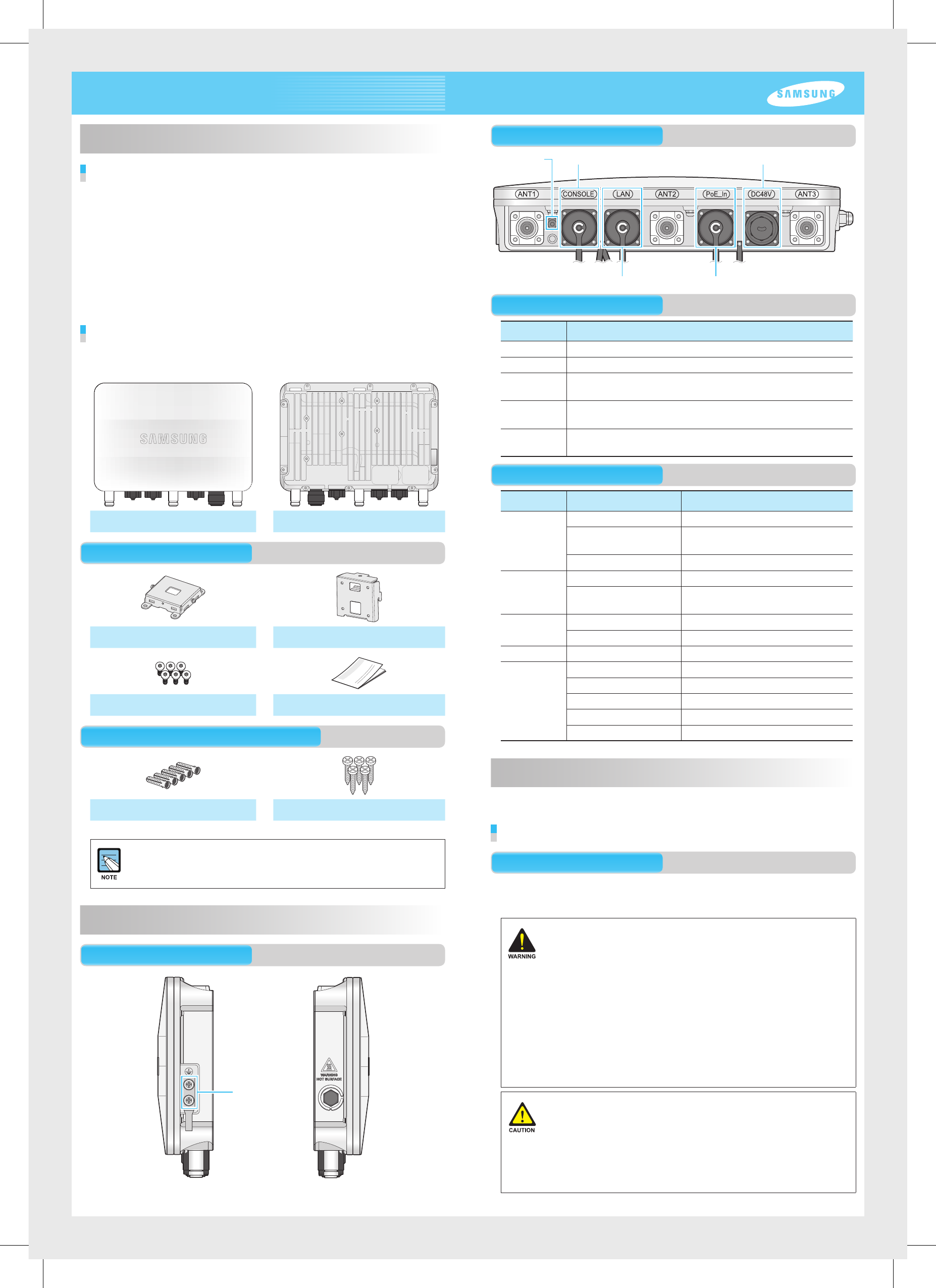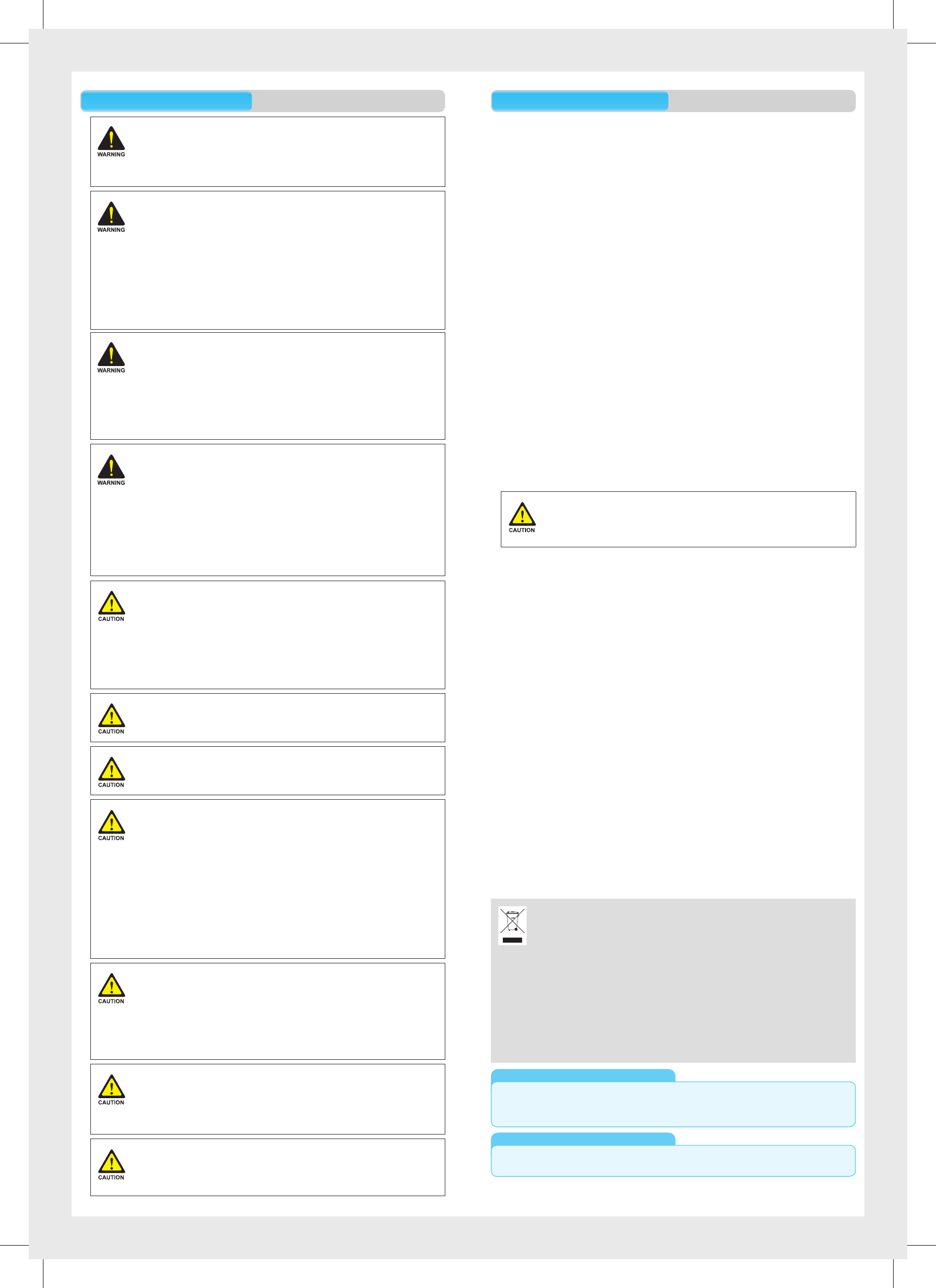Samsung Electronics Co WEA453E WLAN Access Point User Manual
Samsung Electronics Co Ltd WLAN Access Point Users Manual
Contents
Users Manual

WEA453e Quick User Guide
Base
Console Port, Factory Reset Switch
Ethernet Port (PoE)
DC Input
Ethernet Port
LED Status
Indicator
Interface
Interface Description
LED Status Displays the status information of WEA453e using an LED.
DC Input Connects the power adaptor.
Ethernet Port
(PoE)
Supports a 1000 BASE-T Gigabit Ethernet and PoE IEEE
802.3af/802.3at connection.
Console Port Used to check the operational status of the WEA453e and to
input the CLI.
Factory
Reset Switch
Used to switch the WEA453e to the initial factory settings.
LED Status Indicator
LED Status Description
System Start White Initial LED status
Blue Device reset and diagnostic test in
progress
Red Booting failure (device reset failure)
Provisioning Repeating red and green Connecting APC (network link normal)
Blinking green Connecting CAPWAP (APC server
connection status normal)
Normal
Operations
Green No wireless UE connected
Blue Wireless UE connected
Upgrade Blinking blue Upgrading software
Failure Blinking red Network connection failure (physical)
Blinking orange IP address conflict
Blinking violet Dynamic IP address allocation failure
Blinking bluish green Network connection failure (logical)
Repeating Red and Blue Wireless interface failure
Installation
The WEA453e can be installed on a pole or on a wall.
Please confirm that all of the components have been included before installation.
Before Installation
Safety Requirements
Carefully observe the following safety warnings in order to avoid the risk of
damage or injury. Always follow these safety precautions when using the
product.
- There is a risk of electrical shock. Make sure that the
power is turned off during installation. Do not proceed with
the installation if there is any electrical current leaking.
It may cause a serious electric shock.
- Wear anti-static gloves or take an appropriate action to
prevent ESD when handling the product.
- Do not connect a phone line to an Ethernet port.
This may damage the product.
- This product must be connected to a power supply in
compliance with IEEE 802.3af/at or connected to a limited
power supply in compliance with IEC/EN/UL 60950-1.
- This product must be installed or removed by only
appropriately trained service personnel.
- For outdoor use or installation outdoors. For more details,
refer to “Environment” in the IEEE 802.3af/at standards.
- This product must be installed at least 3 m or further away
from a WiBro/3G/4G repeater or antenna.
This manual describes the Wireless Enterprise WEA453e
configuration and installation instructions.
Introduction
What is WEA453e?
The WEA453e is an outdoor Wireless Enterprise AP that supports 802.11ac
specifications. It connects the UE that supports wireless LAN, such as a
smartphone, tablet, or notebook, to a wired network in an outdoor environment.
The WEA453e supports the following features:
- IEEE 802.11a/b/g/n/ac standard
- Power over Ethernet (PoE) IEEE 802.3af/802.3at
- 3 × 3 Multiple Input Multiple Output (MIMO)
- Wireless LAN through both 2.4 GHz and 5 GHz bandwidths
- Temperature Range: -40~+55°C
- Environment Condition: IP67
Components
After unpacking the WEA453e, confirm that all of the following items have been
included:
Front Rear
Common Components
Mount Bracket Unit Bracket
6 M4 × L10 Screws Quick Start Guide
Wall-Mount Installation Materials
5 plastic Anchors 5 M4 × L25 Screws
It is recommended that you keep the box and all of the
packing materials.
Name and Function
Side
Ground Wire

Safety Instructions
Do Not Wear Metal Accessories
Be careful not to short-circuit the power line with any metal
accessories that you may be wearing, such as a watch or
ring.
Using Megger Test Equipment
When using Megger test equipment, keep in mind the
following safety precautions to prevent an electric shock:
- Connect Earth COM (black) and AC.V (red) lead wires with
the correct polarities. At this point, make sure not to touch
the connected probe (reading part of the lead wire) with
your hand or any other physical object.
- While measuring the insulation resistance, never touch the
system.
Connecting the Ground Cable
When connecting the cables, make sure to connect the
ground cable first. When in contact with the system, while
connecting the cable or while maintaining the system
without the ground cable connected, the system can be
damaged due to static electricity and thereby short-circuit,
which could result in an electric shock to the operator.
Turn Off the Circuit Breaker
Since the circuit breaker of the AC Distribution Box is
required to supply power to the system through the
connected power cable, make sure that the circuit breaker
switch on the AC Distribution Box is turned off (open) when
connecting the power connector. If you install the system
with the circuit breaker turned on, it may cause irrevocable
damage to the system and fatally injure the operator at the
time when the cable is incorrectly connected.
Access can only be gained by SERVICE PERSONS or
by USERS who have been instructed about the reasons
for the restrictions applied to the location and about any
precautions that shall be taken; and access is through the
use of a TOOL or lock and key, or other means of security,
and is controlled by the authority responsible for the
location.
Notice! Be careful not to touch the Heat-sink part due to
high temperature.
Round terminals located on the side of a 0.75 mm2 (18 AWG)
or more wires Using permanently connected to earth.
Measuring the Insulation Resistance
Because of the high voltage used while measuring insulation
resistance, carefully adhere to the following safety measures
in order to prevent serious injury and system damage:
- Disconnect all of the cables connected to the system
before measuring the insulation resistance.
- Do not measure the insulation resistance when the power
is live.
- Do not measure the insulation resistance of the units and
parts inside the system except for those designated.
Grounding the System
MGBs for use as a lightning arrester, for power, or for
communication, should be separated. These 3 types of
MGBs can be grounded by the isolation grounding system,
or by the common grounding system, after branching at the
installed mesh underground.
Installing the Antenna
For lightning protection, the antenna must be installed within
the protection angle of the lightening arrester (45° both to
the left and to the right of the central axis).
Cleaning the Power Supply
When cleaning the power supply, it should not be
interrupted as a result of any contact.
Installation Instructions
The following instructions must be carefully observed during installation.
- The system must be easily accessible for product installation, cable
connections, or maintenance.
- The PoE LAN cable must always be installed away from an electrical
interference source, such as a power line, fluorescent light, radio, or transmitter.
- The PoE LAN cable should be a Shielded Twisted Pair (STP) cable at CAT 5E
or higher.
- If the PoE is not easy to use, a power adapter (sold separately) can be
attached. The 3-pin (including ground) power that supplies 100~240 V AC,
50~60 Hz, must be located within 2 m from the equipment and the power
must be supplied through an independent circuit breaker. Equipment that uses
a filter or surge breaker is recommended.
This equipment has been tested and found to comply with the limits for a Class
B digital device, pursuant to part 15 of the FCC Rules. These limits are designed
to provide reasonable protection against harmful interference in a residential
installation.
This equipment generates, uses and can radiate radio frequency energy and,
if not installed and used in accordance with the instructions, may cause harmful
interference to radio communications.
However, there is no guarantee that interference will not occur in a particular
installation. If this equipment does cause harmful interference to radio or
television reception, which can be determined by turning the equipment off and
on, the user is encouraged to try to correct the interference by one or more of
the following measures:
- Reorient or relocate the receiving antenna.
- Increase the separation between the equipment and receiver.
- Connect the equipment into an outlet on a circuit different from that to which
the receiver is connected.
- Consult the dealer or an experienced radio/TV technician for help.
Changes or modifications not expressly approved by the
party responsible for compliance could void the user’s
authority to operate the equipment.
This device complies with Industry Canada licence-exempt RSS standard(s).
Operation is subject to the following two conditions:
(1) this device may not cause interference, and (2) this devicemust accept any
interference, including interference that may cause undesired operation of
thedevice.
Le présent appareil est conforme aux CNR d’Industrie Canada applicables aux
appareils radio exempts de licence.
L’exploitation est autorisée aux deux conditions suivantes:
(1) l’appareil ne doit pas produire de brouillage, et (2) l’utilisateur de l’appareil
doit accepter tout brouillage radioélectrique subi, même si le brouillage est
susceptible d’en compromettre le fonctionnement.
FCC RF Radiation Exposure Statement:
This equipment complies with FCC RF radiation exposure limits set forth for an
uncontrolled environment.
This equipment should be installed and operated with a minimum distance of
50 cm between the radiator and your body.
This transmitter must not be co-located or operating in conjunction with any
other antenna or transmitter.
RSS-102 RF Exposure
L’antenne (ou les antennes) doit être installée de façon à maintenir à tout instant
une distance minimum de au moins 50 cm entre la source de radiation (l’antenne)
et toute personne physique.Cet appareil ne doit pas être installé ou utilisé en
conjonction avec une autre antenne ou émetteur.
WEEE SYMBOL INFORMATION
This marking on the product, accessories or literature indicates that the
product and its electronic accessories (e.g. charger, headset, USB cable)
should not be disposed of with other household waste at the end of their
working life. To prevent possible harm to the environment or human health
from uncontrolled waste disposal, please separate these items from other
types of waste and recycle them responsibly to promote the sustainable
reuse of material resources.
Household users should contact either the retailer where they purchased this product,
or their local government office, for details of where and how they can take these items
for environmentally safe recycling.
Business users should contact their supplier and check the terms and conditions of the
purchase contract.
This product and its electronic accessories should not be mixed with other commercial
wastes for disposal.
Class B Equipment (For Home Use Broadcasting & Communication Equipment)
This product is home use (Class B) electromagnetic wave suitability equipment designed
to be used in all areas of the home.
Electromagnetic Wave Suitability Notice
Wireless equipment may interfere with radio waves while operating.
Services related to safety of life cannot be provided.
Caution
Part No.: EC68-00186A (Ver.1.0)